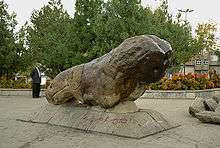Hamadan Stone Lion
The stone lion of Hamadan (Persian: شیر سنگی همدان šir-e sangi-ye hamedân) is a historical monument in Hamadan, Iran.
The stone lion -one part of the 'Lions Gate'- sits on a hill where a Parthian era cemetery is said to have been located.
When first built, this statue had a twin counterpart for which they both constituted the old gate of the city. During the Islamic conquest of Persia, the victorious Arabs referred to the gate as bâb ul-asad (Persian: بابالاسد, "the lions gate").

The gates were demolished in 931CE as the Deylamids took over the city.
Mardāvij unsuccessfully tried transporting one of the lions to Ray. Angered by the failure to move them, he ordered them to be demolished. One lion was completely destroyed, while the other had its arm broken and pulled to the ground. The half demolished lion lay on its side on the ground until 1949, when it was raised again, using a supplemental arm that was built into it.
In 1968 Heinz Luschey demonstrated that the lion is a Hellenistic sculpture and that the lion monument at Chaironeia (erected soon after 336 BC is comparable. His interpretation that it was built by the orders of Alexander the Great to commemorate the death of his close companion Hephaestion in 324 BC.[1] is adopted by Iran's Cultural Heritage Organization.
References
- ↑ Arrian, The Campaigns of Alexander, translated by P.A. Brunt, with Greek and English text, edited by Jeffrey Henderson, The Loeb Classical Library, Harvard University Press. Books I-IV: ISBN 0-674-99260-1 Books V-VII and Indica: ISBN 0-674-99297-0
- General references
- Luschey, H. Der Löwe von Ekbtana, Archäologische Mitteilungen aus Iran 1, 1968, 115-129
- Simaye Miras-i Farhangi-i Hamedan, Iran Cultural Heritage Organization, ISBN 964-7483-68-6, 2003
- Fox, R. L. Alexander the Great (Page Number: 434), Penguin Books, London
| Wikimedia Commons has media related to Shir Sangi Hamedan. |
